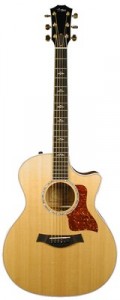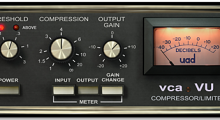Technology is allowing just about anyone to record music without venturing into a traditional recording studio. That’s good and bad.  Recording engineers are worth their weight in gold (or more). It is the engineers that make the recordings we hear on iTunes or a CD sound the way they do. Their contribution to the songs should never be underestimated.
Recording engineers are worth their weight in gold (or more). It is the engineers that make the recordings we hear on iTunes or a CD sound the way they do. Their contribution to the songs should never be underestimated.
However, a lot of people these days see technology as the savior. That can be dangerous for the sound of your music.
I am a firm believer in recording an instrument when it sounds the best it can be. That means setting up the mics, taking into account positioning, phase issues and everything else that goes along with micing an acoustic guitar.
Technology can be used to enhance what you record, but don’t rely on it to “fix” issues that should be resolved before recording starts.
![]() I use a Taylor 516ce acoustic for a number of reasons. First and foremost, it is one the best sounding acoustics I’ve ever played. What I hear from that guitar is exactly what I want when I record — in other words, no fixing or adjustments are needed to get the tone I’m looking for.
I use a Taylor 516ce acoustic for a number of reasons. First and foremost, it is one the best sounding acoustics I’ve ever played. What I hear from that guitar is exactly what I want when I record — in other words, no fixing or adjustments are needed to get the tone I’m looking for.
I’m also using AKG mics, which I use for acoustics, electric guitar, drums, room mics and everything else I record. I used a couple of different mics to record the acoustic including the AKG 451 and the 414.
I used the Mid-Side technique (thanks David Barnard for the input) with a 451 pointed at the guitar and the 414 in a figure eight as the side mic. Knowing how my Taylor sounded, I knew the exact sound I wanted from my recording. This technique delivered a really crisp sound.
I prefer a brighter, warmer sound from my acoustic, rather than a boomy low-end heavy sound. That’s a choice you’ll have to make for yourself and move the mics accordingly.
On the advice of producer and engineer, Brady Barnett, I also tried using two 451s pointed at the guitar. I moved the mics around until I hit the sweet spot at about six-inches away. One mic was to the neck side of the sound hole, the other up the neck a bit further.
As Barnett pointed out, the exact position of the mics depends on a number of factors including the guitar being used and the guitar player.
You also have to consider the room you are recording in. There are a lot of things to take into account when recording, so it’s important to do your homework.
Ultimately, of all the technique’s I tried over a few days of playing with mics and positioning, Barnett’s worked out the best. It captured the essence of the Taylor that I was looking for.
 The only thing I did to the recording was add a little bit of compression using Universal Audio’s VCA VU Compressor. It’s probably one of the easiest to use compressors on the market, but delivers results every time.
The only thing I did to the recording was add a little bit of compression using Universal Audio’s VCA VU Compressor. It’s probably one of the easiest to use compressors on the market, but delivers results every time.
Many people these days think the work starts when you hit the record button in Pro Tools or Logic. Actually, the real work should begin long before you ever sit down in front of your computer or recording gear.
